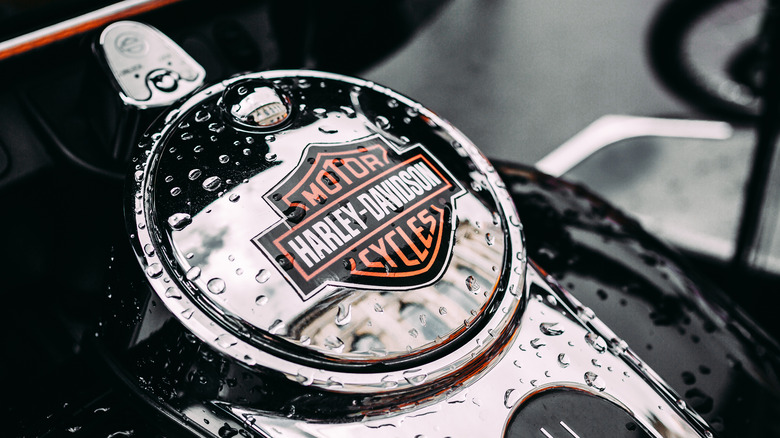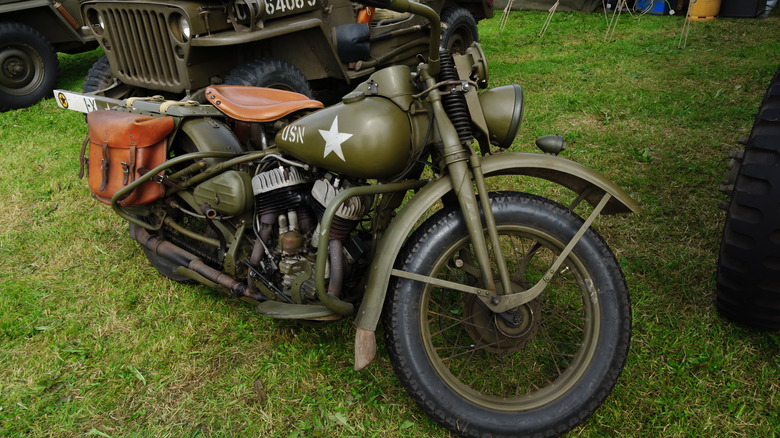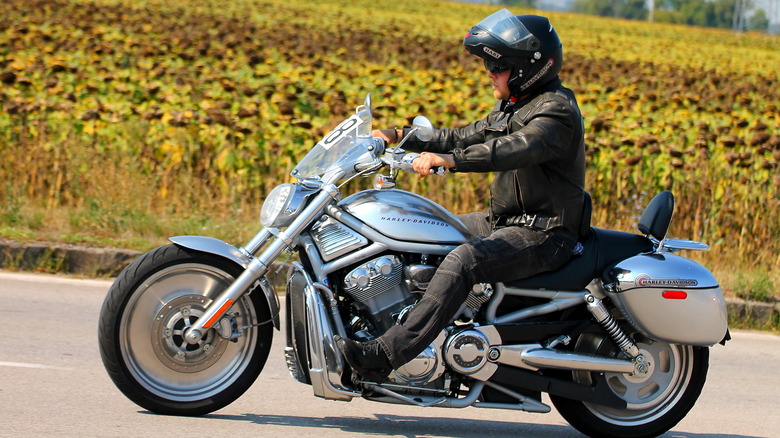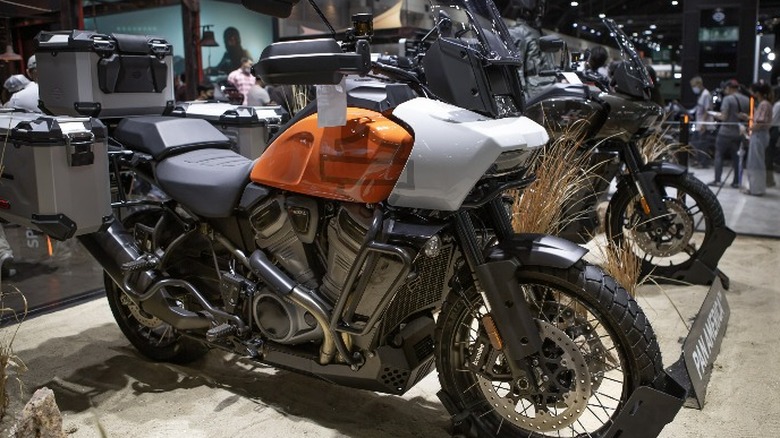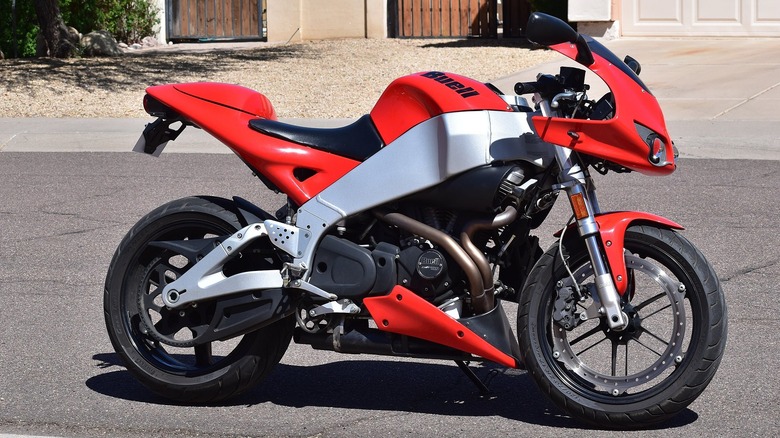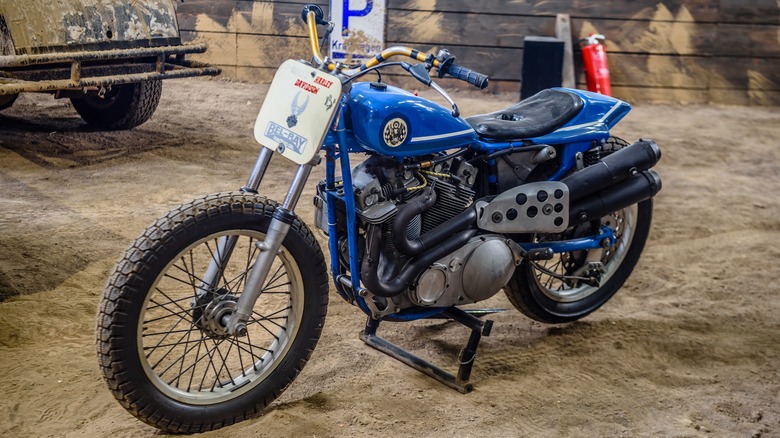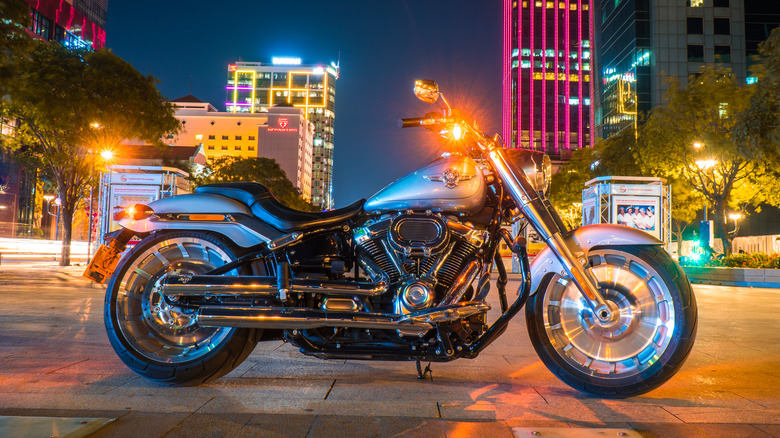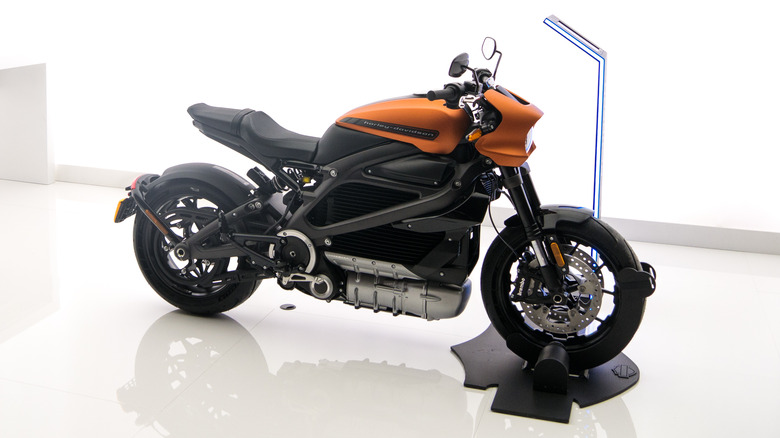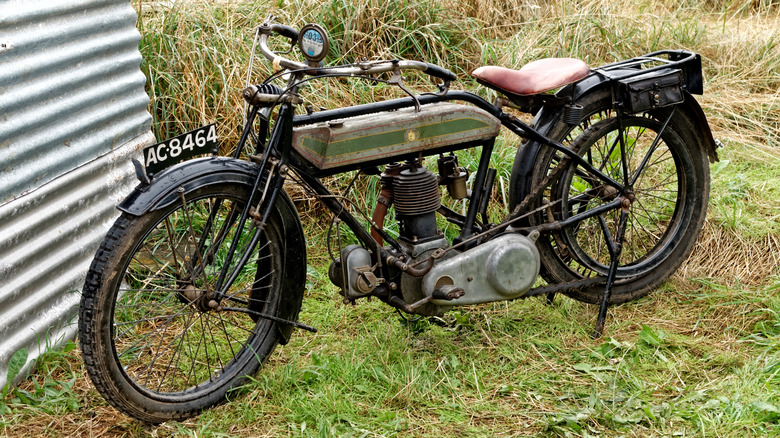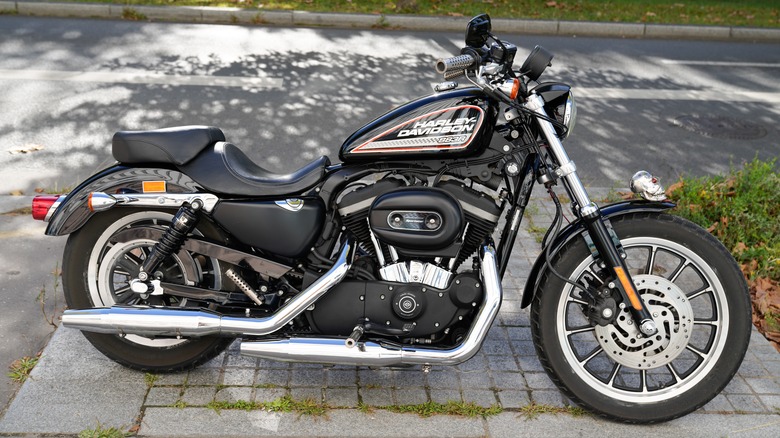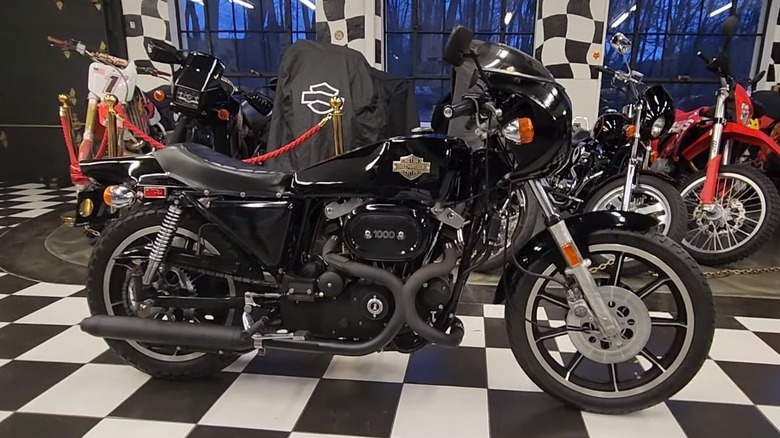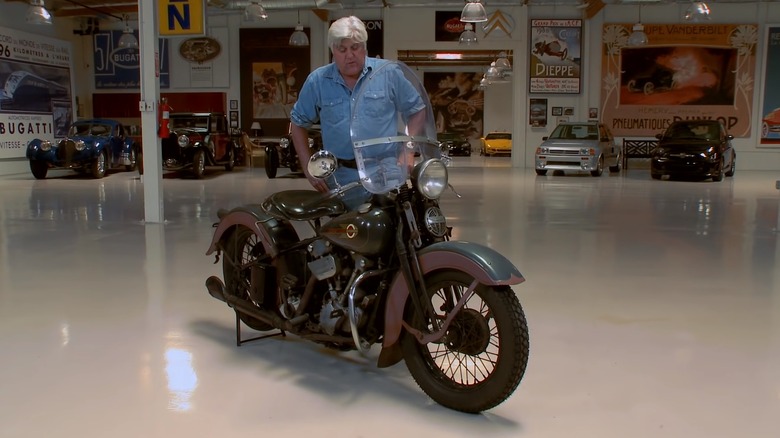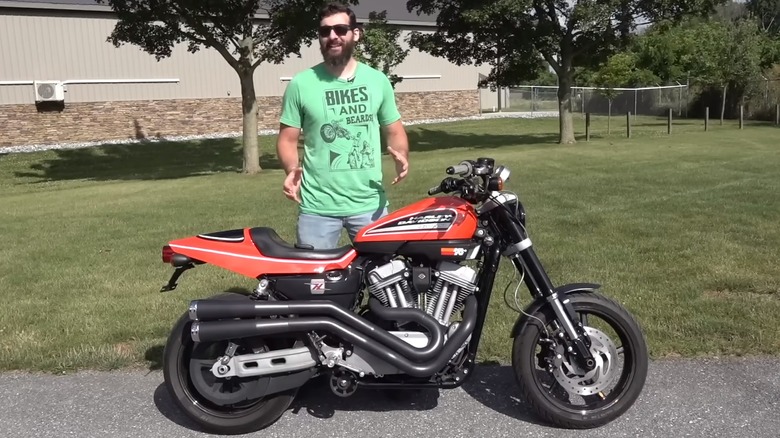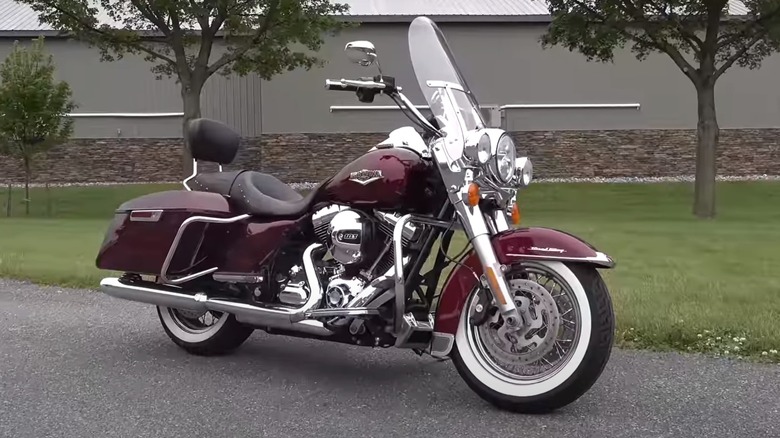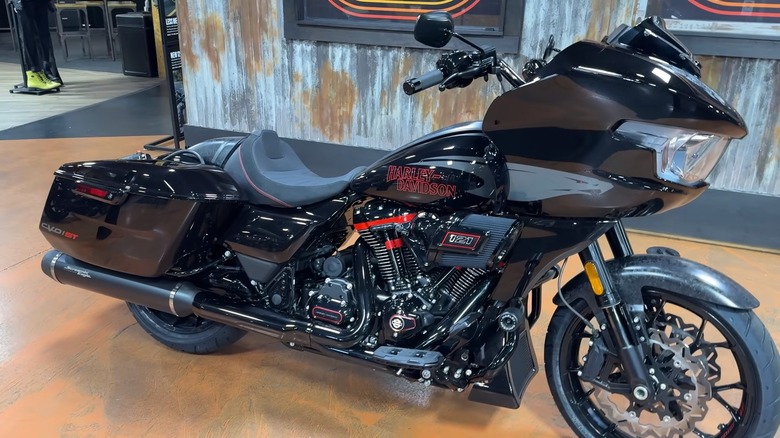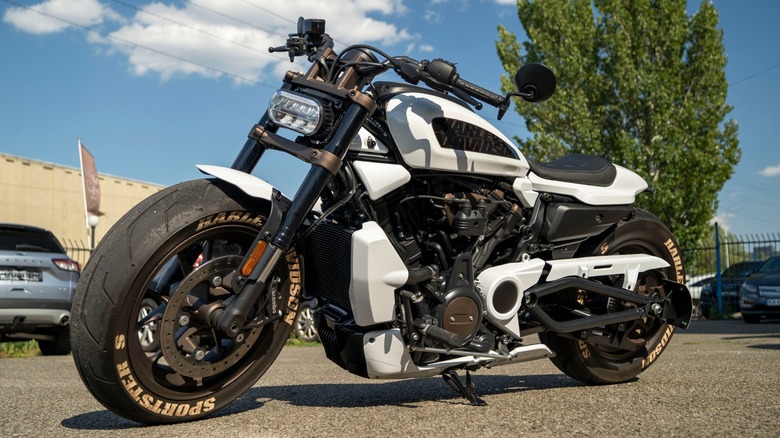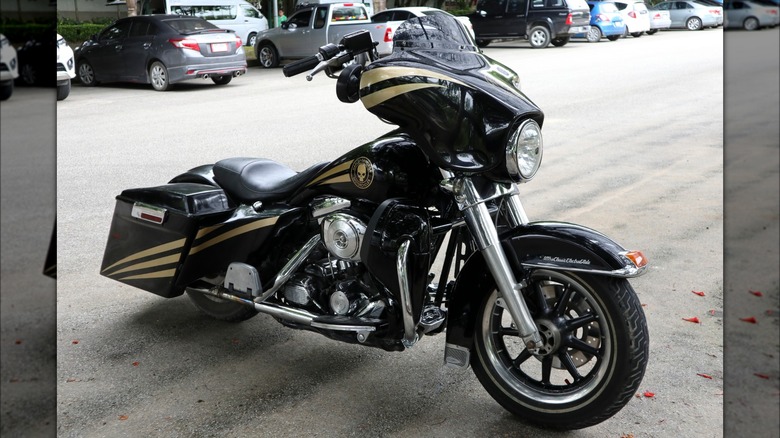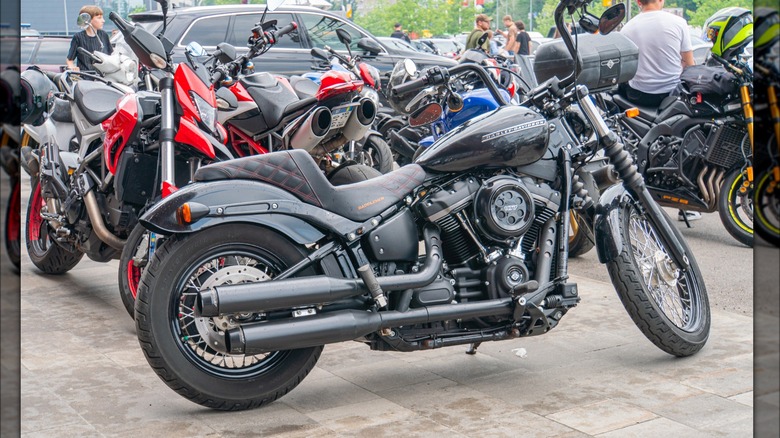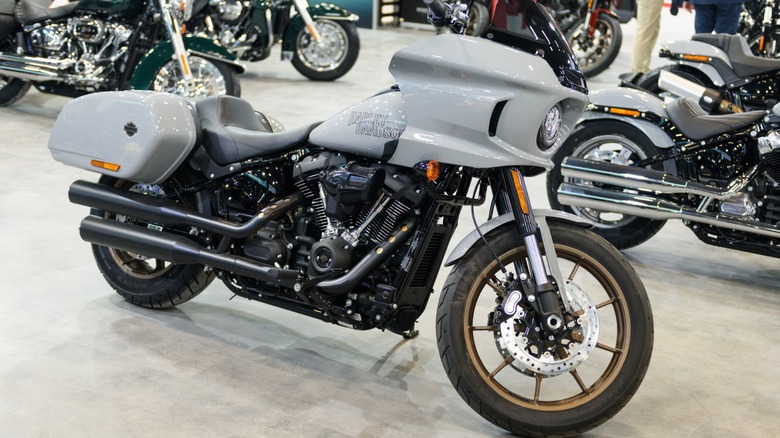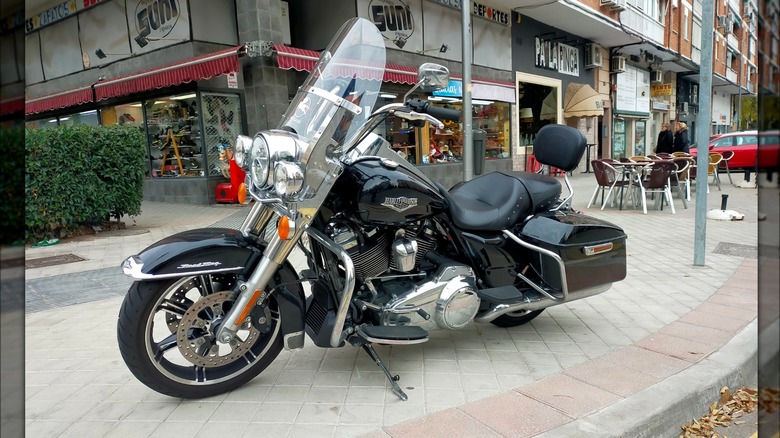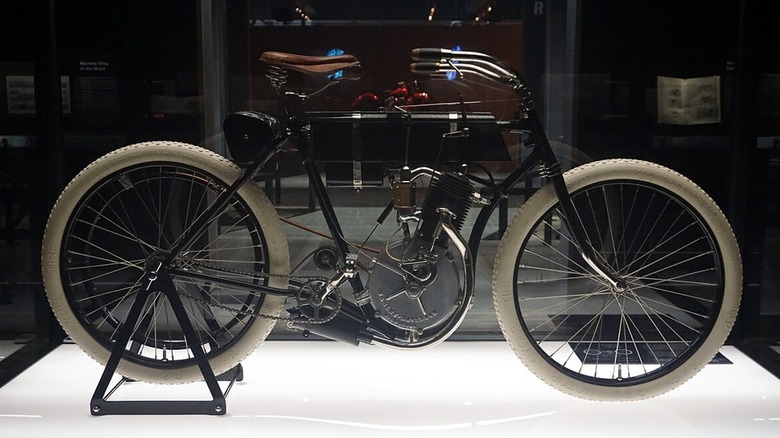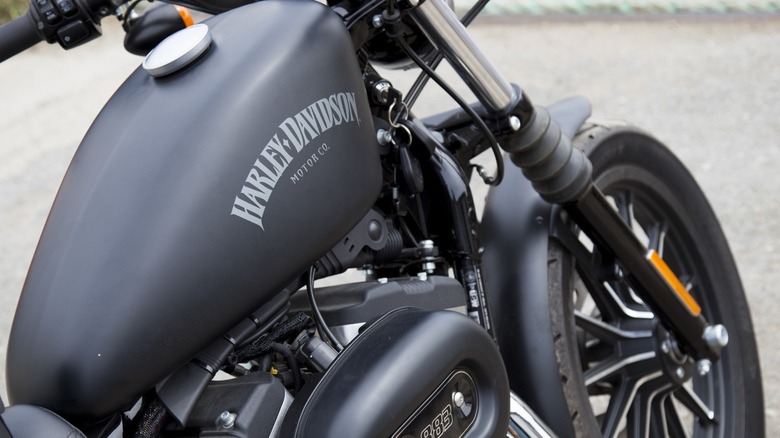20 Of The Best Harley-Davidson Motorcycles Ever Made
The Harley-Davidson motorcycle company has been manufacturing motorcycles in the U.S. since 1903, even surviving the Great Depression. It has been a company with many owners over the years, and threats of bankruptcy are just as numerous. But, through the years, H-D has not only made motorcycles but also a lifestyle. Harley is no longer just a motorcycle company; it's a part of American society and a cultural icon.
With more than a century of building motorcycles, Harley will have plenty of models to talk about, some better than others. There was a time through the years spanning from 1969 to 1981 when the company was owned by AMF, which is most closely associated with bowling balls and equipment. This is also the period when most Harley owners will say the quality had gone so far downhill, it fell into a ravine.
Although quality fell precipitously during the '70s, it finally rebounded, and the modern Harley-Davidson motorcycle is a reasonably well-built machine, and plenty of folks are willing to lay down exorbitant amounts of cash for a new one — the top-of-the-line model retails for more than $46,000. So, we dug deep into the archives of Harley-Davidson's motorcycles to come up with these 14 best bikes from the legendary Milwaukee company.
Harley-Davidson WLA Liberator
Talking about Harley's contribution to American society would be incomplete without mentioning its contribution to World War II. Contracted by the military to provide motorcycles to the U.S. Army, Harley provided the WLA "Liberator." The motorcycle Harley provided was tough and durable, if not particularly light at more than 500 pounds. It used an older flathead engine that was cheaper and easier to produce and had already proven to be reliable and tough. It would also make it easier to repair in the field as soldiers often have to fix their machines on the go. In the end, Harley sent nearly 100,000 motorcycles overseas.
Without these durable machines, the Allies likely would have still won the war, but the contribution from Harley-Davidson made an impact. They were used mostly for escort, scout, and police duties and not for combat roles. Up to a third of the war production was sent to our Soviet allies, as well. After the war, however, Harley experienced difficulties getting raw materials as so much effort was put into rebuilding Europe's economies. This later led to cheap imported machines flooding the U.S. market and hampered Harley's efforts to expand after the war, according to the Motorcyclist.
After the war, tens of thousands of these motorcycles were left at home and abroad and former soldiers and civilians bought them up, altering them for civilian service. This makes original bikes with olive green paint and identifying military symbols exceedingly rare today.
Harley-Davidson V-Rod
The V-Rod may not have been the most popular Harley-Davidson motorcycle, but it is still an incredible bike, and it sold for an impressive 16 model years. The engine, dubbed Revolution by the company, debuted many firsts. Harley-Davidson has long prided itself on its reputation of history, creating bikes year after year with few radical changes to form or function. Small improvements came out every few years and tweaks in design differentiated model years. But the V-Rod brought out the first Harley with fuel injection, overhead cams, and water-cooling all at the same time. The Revolution name was apt.
Since the company had been perfecting an engine design dating to before WWII, Porsche Engineering was brought on board to aid in development. The resulting engine was thoroughly modern and delivered a respectable 120 horsepower. For the first time, a Harley rider could sit at traffic lights without a wave of heat rising from the engine. The styling was also more aggressive, taking on a more sporty look while retaining the classic American motorcycle lines.
Despite its fairly long tenure, it does not get much love from die-hard hog fans. It was meant to compete with Japanese bikes and draw in a different buyer. The Drive quotes a common refrain that there are plenty of motorcycle riders who proclaim they would never buy a Harley ... except for a V-Rod.
Harley-Davidson Pan America 1250
The Revolution engine contributed greatly to the evolution of Harley-Davidson as a brand and its attempts to attract new buyers, resulting in one of its current offerings: the Pan America 1250. It is a stunning departure from the glitzy chrome-emblazoned cruisers Harley is known for. The Pan America feels as comfortable off-road as on, but also benefits from the large, torque-heavy V-Twin engine. While dresser Harleys are built on tradition, this one is built on technology and performance.
This motorcycle utilizes the Revolution X engine with overhead cams and water cooling. It sits tall and has a large travel distance for the adjustable and adaptable suspension to help it tackle rugged terrain. It is kind of the anti-Harley, however, the company is working to diversify its offerings and wants to expand its customer base as part of its "More Roads to Harley-Davidson" product strategy, according to Rider Magazine. The Pan America also opts for a full digital display over gauges and offers a range of settings to riders. It is yet to be seen whether this will achieve the goals of the company, but if this kind of bike is what can be expected, Harley should be seeing a new breed of buyers to the brand in its next chapter.
Buell Motorcycle Company
To be fair, Buell motorcycles are not Harley-Davidson motorcycles, but they were inextricably linked for many years. Erik Buell was an engineer at Harley-Davidson and originally created a motorcycle just for racing. That eventually grew into a manufacturing business, of which Harley-Davidson bought a sizable interest in 1993, and then 98% ownership in 1998. Throughout its existence, Buell produced road-going motorcycles of a sports racer variety using Harley V-Twin air-cooled engines. The bikes were sold as a companion brand to Harley, providing an option for customers looking for something other than the cruiser and touring bikes typical of H-D.
Buell bikes featured many innovations such as making the engine part of the frame, turning part of the frame into the fuel tank, and using a unique braking system with the disc connected to the outer rim of the wheel. While the bikes often sold better than Buell's expectations, they often did not fit in well within the Harley family. CEO Keith Wandell is said to have remarked about "Erik's racing hobby" and asked, "why anyone would even want to ride a sportbike," showing a clear lack of understanding of the motorcycle market as a whole (via Motorpedia). Despite producing some clever bikes and being the only American manufacturer of sportbikes, Harley closed up shop in 2009 and Buell motorcycles ceased to exist. However, Erik Buell is back with a new line of motorcycles.
Harley-Davidson XR750
Harley-Davidson has been committed to racing from its origins. Some of the earliest racing was done on oval tracks of dirt and that continues to be a popular sport today called flat track racing. While the early days would have motorcycles coming straight from the factory and set to race, once the manufacturing and the racing matured, purpose-built machines would follow.
Harley made flat track machines for years, but it was the XR750 that became a legend. It was presented by Harley for racing in 1970, according to Silodrome. It was an immediate success and went on to dominate the sport for decades. In the period from 1972 to 2008, it won 29 of 37 AMA Grand National Championships. The bike's best-known publicity came from its use by daredevil superstar Evel Knievel in his death-defying stunts. It is a competition machine and not offered through dealers, nor is it listed on the company website, but it has been an important part of Harley's history. It stayed in production until being replaced by the water-cooled XG750R in 2015.
Harley-Davidson Fat Boy
Fat Boy joined the Harley-Davidson lineup in 1990 and has been a mainstay for the brand ever since. Characterized by its low riding position, wide front forks, and fat tires, it is a great cruiser bike for the rider who does not want the extra bulk and weight from a full touring model but wants something more substantial than a Sportster.
The Fat Boy is part of the Softail family and uses a clever hidden rear suspension to give it the look of old bikes with a rigid frame. In addition to the thick shocks, early Fat Boys are distinguishable by their solid disc wheels, although the current lineup uses slotted wheels with a diminished disc in the center. According to Motorcycle News, the company in the '80s was languishing and struggling to find growth, relying on its heritage in designs and failing to refresh the styling. Willie G. Davidson, the grandson of one of the company founders, came up with this new look as a fresh take on the cruiser bike with a clean look that highlighted all the best of the classic Harley style. It worked and helped with a resurgence in cruisers in the '90s. It did so well that it has been in the lineup ever since.
Livewire One
Choosing the Livewire will surely ruffle some feathers. It has no chrome or tassels, but it does have the ability to propel Harley-Davidson as a company well into the future. No matter how much anyone may not like electrically propelled motor vehicles, they are here and the market share will be growing. It makes sense that Harley would step into this space and build an American version of the future.
Harley-Davidson first brought out the Harley-Davidson Livewire motorcycle in 2019 but has since spun off its electric division into a stand-alone entity simply called Livewire, which now offers two models. The original bike, now called Livewire One, is mostly unchanged from the first release, but no longer covered in traditional Harley-Davidson colors. When Harley first released an electric motorcycle, a huge criticism was its retail price of nearly $30,000. The new Livewire model, as MotorBiscuit explains, has addressed that with a price drop to a more manageable $22,799. It is full of tech, has a range of 146 miles, and can charge from zero to full in an hour on level 2 charging. And the 100 horsepower engine and instant torque of the electric motor will make it feel like it's taking off every time you ride it.
The bottom line is that this is the future. If the dedicated fans of the brand want it to survive, they should embrace this model, because it is the key to remaining relevant. That is why it is one of Harley's best bikes.
Harley-Davidson 11F
Harley-Davidson was founded in 1903, beginning by fitting what were essentially bicycle frames with engines and fuel tanks. Once the company saw that it could be successful in this endeavor, it expanded its capabilities and technology at a rapid pace in the following years. By 1915, several innovations had been developed and its 11F model was introduced, showcasing many new features for the first time.
With the 11F, Harley equipped the bike with a new V-Twin engine, a new three-speed transmission, and a magneto with an electrical lighting system. The V-Twin engine was an improved engine with larger valves and it moved the intake valve to an overhead position while keeping the exhaust as a side valve. The bike also received an automatic oiler, meaning riders no longer had to stop to oil the valve train repeatedly on the road. Harley-Davidson was so sure of its new motorcycle that it advertised it as having 11 horsepower and backed that up in writing, something other motorcycle manufacturers were reluctant to do at the time.
Harley-Davidson Sportster
The Sportster motorcycle series has been a mainstay in the Harley-Davidson lineup since 1957, changing often in technology, but not style. From the start, the Sportster was the midsize offering from Harley with its OHV 883cc engine, upgraded from the 750cc flathead K model it replaced. It was a response to the lightweight British bikes being imported at the time from Triumph, BSA, and Norton. While some of the competition has long since closed, the Sportster remains the entry-level Harley, with the Sportster S being one of its latest models.
From the '50s to the '70s, Harley-Davidson tried to attract buyers of small motorcycles by importing and rebadging light European motorcycles with only moderate success. However, by 1979, that practice ended and the Sportster became the smallest of the Harley lineup until the Street 500 joined the lineup from 2014 to 2020. Sportsters are a perfect mix of being a motorcycle with lots of torque and good size while remaining easily managed in any traffic. They're also great for those who like to ride but have no need for open-road touring.
Harley-Davidson XLCR
While Harley-Davidson is best known for its production of big V-twin cruisers, the company has built many interesting models that veer outside of the norm for the company from time to time. Some of these turned out to be great bikes that failed to catch on for one reason or another, such as the 1977 to 1979 Harley-Davidson XLCR.
Built at a time in which Japanese imports were gaining ground and displacement, the traditional builder of big cruisers released this model to compete. Born as a cafe racer, the XLCR, or "Excelsior," eschews the traditional Harley chrome, oversized fenders, and swept-back handlebars for an all-black color scheme with only the smallest of fairings over the headlight and cluster all installed in a package meant to be ridden hard and fast rather than low and slow.
Ultimately, XLCR failed against increasingly fierce competition from Japan. Its low-revving engine was powerful enough but heavy with vibrations at the high speeds cafe racers are generally built for and generally built with old and inferior technology. After just three years of abysmal sales, Harley pulled the plug. The XLCR stands as one of many examples of how Harley-Davidson could innovate and try to adapt to market trends only to be foiled by buyers steeped in the company's legacy steering clear of anything outside of the norm on which the company was built. Even though it was not a great seller, the Harley-Davison XLCR was an interesting boundary-pushing model that is now a highly collectible machine.
Harley-Davidson EL Knucklehead
In the middle of the Great Depression, introducing a new motorcycle model was no guarantee of success, although not introducing anything new could be just as perilous. Harley-Davidson chose the former when it released an all-new design in 1936 called the Harley-Davidson EL, which later gained the "Knucklehead" moniker due to its enlarged rocker boxes.
Stylistically, the 1936 model was not a significant departure from the previous model, although it did feature a new streamlined tank with some Art Deco details throughout the bike. The biggest breakthrough in 1936 was Harley's first overhead-valve engine. Available in sizes of 61 or 74 cubic inches, the Knucklehead provided a significant boost in power thanks to its improved airflow, raising power from around 30 horsepower to about 40 on the smaller engine and up to about 45 on the larger one. Furthermore, for the first time, the oil was fully contained in a recirculating system and riders no longer had to contend with the total-loss lubrication system that dripped from a tank into the engine and then to the ground.
The bikes of this period display an elegance unmatched by modern bikes. While modern riders must contend with some archaic engineering, they remain a joy to ride, and they represent an important step in the evolution of the brand. Furthermore, the 1936 Harley-Davidson EL is among the rarest of Harleys and can sell for exorbitant sums at auction today.
Harley-Davidson XR1200
In the tradition of Harley-Davidson veering away from its core product mix to build a bike competing in a different market segment, it introduced the XR1200 in 2008. Built to attract European buyers who preferred a capable sport bike over a big cruiser, Harley courted that demographic so much it initially offered this model only in Europe.
At the heart of this bike is the signature Harley V-twin engine and a callout to the highly successful Harley-Davidson XR750 flat-track racer. This one has been tuned to produce 91 horsepower, and while it retains the traditional air cooling, oil cooling was added to the heads to help control the heat from its added power – for comparison, a 2012 Sportster 1200 Custom makes only 67.7 horsepower. Adding to this Showa suspension and Nissin brakes, the XR1200 turned out to be a good performer that benefited from the low-end grunt Harley engines are renowned for. Furthermore, its styling works and manages to take the big V-Twin and package it in a modern and sporty package that looks at home on a twisting country road.
Even though Harley responded to its dealers' demand for the bike and offered it Stateside in 2009, sales never matched its potential. Like Harley's other sporting attempts before it, sales figures disappointed. With similar imported bikes offering as much or more performance for less money, buyers did not flock to Harley dealers and the XR1200 ended in 2013.
Harley-Davidson Road King FLHR
In speaking about the brand Harley-Davidson, the Road King FLHR sums it up both in its name and its looks. Few models from the brand look more "Harley" than a Road King, and few names match how you feel while saddled up on a Road King while out on the open highway.
Debuting in 1994, the Road King joined Harley's lineup of touring motorcycles and remains a part of the lineup today. This model represents the style established by Harley going back to the '40s and maintained with updates over the decades. It remains a large V-Twin touring bike without the bulk of the added fairings and luggage cases of the bagger bikes. It is the essence of Harley-Davidson, which is probably why Road King has been a part of the lineup for so long.
The Road King was also introduced at the perfect moment when a Harley can maintain its heritage appeal while offering modern amenities. It received fuel injection two years after its introduction and every technical update Harley has had to offer ever since. The Road King is the bike for the Harley purist who wants to ride in style without being burdened by too much. Those who love the classic look of a Harley but want to avoid the pitfalls of classic motorcycle ownership are the ideal Road King buyers, and that is why it has been one of the best Harleys ever since it was introduced.
Harley-Davidson CVO Road Glide ST
For anyone who wants to walk into their local Harley dealership and buy the biggest and baddest cruiser available, the bike of choice is the Harley-Davidson CVO Road Glide ST. This is a top-of-the-line bagger-style motorcycle built upon Harley's Road Glide line and enhanced by the Custom Vehicle Operations division, Harley-Davidson's in-house custom motorcycle builder, which modifies Harley's best bikes to create limited-edition machines with distinctive features.
Moving this big bike is the latest Harley-Davidson V-Twin engine displacing 121 cubic inches, or 2.0 liters, featuring all the latest in engine technology, such as variable valve timing, fuel injection, and liquid-cooled cylinder heads. However, the highlights of this machine revolve around comfort and luxury. Riders benefit from a laundry list of extras like a broad digital display with variable screen settings, navigation, audio system with wireless helmet connectivity and Apple CarPlay, and 500 watts of Rockford Fosgate power to the 6.5-inch fairing speakers. Otherwise, while the bike handles well and can be taken through some twisties with reasonable ease, it is built for all-day cruising comfort, and its broad saddle and footboards make it the perfect place to be for a long ride.
While the CVO Road Glide St represents the ultimate in Harley two-wheeled cruising, it also represents a substantial investment. With an asking price of $42,999, you might find one of several excellent cars to buy in its stead. But then again, they wouldn't be a Harley.
Harley-Davidson Sportster S
In the minds of many motorcycle riders, the Sportster name holds an association with a more affordable version of American V-twin motorcycle featuring an inferior engine lacking the displacement of a 'proper' Harley-Davidson V-twin that only serves as a placeholder until one can buy a 'real' Harley. While that may or may not be a deserving attitude, the modern Sportster S shatters any notion that the Sportster is a lesser machine reserved for novices.
With air-cooled engines becoming increasingly harder to pass emissions standards, Harley-Davidson had to rethink its lineup and some of its models with aging air-cooled engines. This led to essentially scrapping the Sportster line altogether, only to be replaced with a rebirthed version featuring the new liquid-cooled Revolution Max V-twin in 2021. Furthermore, styling of this bike took a new direction, emerging as a modern bobber complete with fat tires reminiscent of models from the 1930s.
With its 1250cc V-twin engine serving as a stressed member of the frame, the Sportster S shed weight while raising refinement, delivering excellent handling with its 120 horsepower output providing abundant power. While purists who only want a big bike dressed with ample chrome and heritage styling will likely never take to the Sportster S, beginning riders and sportbike riders looking for a change will love it. Furthermore, it is a fitting successor to the original Sportster, one of the most successful Harley-Davidson models ever made.
Harley-Davidson Street Glide Ultra
Most riders know that a Honda Goldwing is an excellent motorcycle for extra-long journeys – but for those who want that all-day riding comfort with the style and panache that only a Harley-Davidson can deliver, the newly redesigned Street Glide Ultra is the ultimate choice.
For the 2025 model year, Harley has delivered riders a stout machine with power and refinement. Some of the highlights of the updated model include added cushioning for both rider and passenger, increased storage capacity, and reduced weight. Furthermore, the suite of features include advanced technologies once reserved for luxury cars, such as linked anti-lock brakes, traction control, drag torque slip control, and even tire pressure monitoring. This is all accompanied by a dynamic 12.3-inch TFT touchscreen with Bluetooth and a healthy 200-watt audio system.
The Milwaukee-Eight 117 V-twin upholds the heritage of air-cooled American bikes but shoots coolant through the heads for effective cooling and efficient operation. While its 105-horsepower rating may seem modest, the 130 lb-ft of torque is what matters on a bike that is made for cruising. For a hefty touring machine with plenty of style, it is hard to go wrong with Harley's newest Street Glide Ultra.
Harley-Davidson Softail
In 1984, Harley-Davidson introduced what could be considered a revolutionary motorcycle design. Throughout its early history, Harley's bikes lacked a rear suspension, a design commonly called hardtail. These bikes defined the Harley look for decades, evolving into the familiar heritage styling that became a hallmark of a Harley-Davidson. While technology progressed and Harleys received a rear suspension, buyers still appreciated the heritage styling — so Harley gave them the best of both worlds with the Softail.
With a new design created by mechanical engineer Bill Davis, the new Softail was presented sporting the classic look of the old hardtail bikes while offering a smooth and refined ride. The new bike proved to be incredibly popular, and it led to the release of the 1986 FLST Heritage Softail, which came out looking fresh off a 1950s assembly line while riding like a modern motorcycle.
Success of the Softail design cemented its place in Harley-Davidson model development and continues to be used today. It has become such an integral part of the company that no Softail is listed on any model of the current lineup, but you can see it is used on bikes like the Street Bob and the Breakout, which are among the best Softails ever built.
Harley-Davidson FXRT Sport Glide
In 1983, Harley-Davidson released a new sport-touring bike called the FXRT Sport Glide. It was not a revolutionary kind of bike, although it featured several upgrades from predecessors, such as rubber engine mounts to reduce vibration. Its styling carried on in the traditional Harley style and continued to offer riders a high degree of comfort that many had come to expect from a full-size American bike. In many respects, it would seem the Sport Glide would be at least somewhat unremarkable, but it symbolizes something much bigger than itself, and that is why it remains one of the best.
Throughout the 1970s, Harley-Davidson suffered from multiple issues and even a few calamities under the management of its AMF corporate overlord. With the company teetering on the brink and its future uncertain, a group of top brass at the company pooled their resources and submitted an offer to buy the company from AMF outright. Successful with their ploy and with full ownership of an American icon, the new company bosses had to deliver something if their gambit would succeed, and the Sport Glide was the first new model out of the gate.
The Sport Glide departed from typical Harley styling thanks to the fairing and luggage boxes influenced by the defunct V4 Harley-Davidson Nova prototype engineered by Porsche. Nevertheless, it helped bring Harley back from the brink to become the powerhouse it is today.
Harley-Davidson Road King
With Harley's turnaround in the 1980s, its popularity soared by the mid-'90s. With increased demand and a steady stream of buyers, it was time for a new model. Even as Harley sped into the future, it harkened back into its past for inspiration for what would become the all-new Road King.
Introduced in 1994, the Road King emulated the iconic Knucklehead V-twin FL models of the early '40s. Sporting details such as a large headlight sitting in front of a windshield with no fairing and a pair of hard saddlebags, the FLHR was a real ringer for the old FL. However, equipped with an Evolution V-twin made ever more refined over the previous decade, the Road King offered riders the ultimate in stylish riding with modern reliability and ample power.
The Road King proved to be a popular model as it remains in the lineup today. Now equipped with the Milwaukee Eight V-twin, it offers more refined power than ever. With continuous upgrades such as traction control, Brembo brakes, and Showa suspension, today's Road King is a surprisingly easy bike to handle, despite its girth.
Harley-Davidson Model No. 1
After building a couple of prototypes in 1903 and 1904, the fledgling Harley-Davidson motorcycle company built its first production bike in 1905 — the Model 1. By today's standards, it was woefully underpowered, unrefined, and crude, looking more like a motorized bicycle than a real motorcycle. However, by contemporary standards, it was good enough to launch a company that would survive worldwide conflict, a depression, buyouts, and intense competition from the Japanese motorcycle market.
William S. Harley and Arthur Davidson originally built motorcycles to go racing, which is exactly what they did with their first couple of bikes. As they refined their machines and worked to improve them, a production version emerged from their tiny factory, which was essentially just a wooden shed on Chestnut Street in Milwaukee. Regardless, something about the Model 1 ticked the right boxes as Carl H. Lang of Chicago sold three of the first five bikes built. The next year, they sold 50. More than 100 years later, the company would be worth billions and recognized around the world.
The Model one featured a 24.74 cubic-inch single-cylinder engine that could push the 185 pound bike up to about a 40 mph top speed. It had no electric starter nor a kick starter, but it did have pedals to help you get it going and kick it into gear. The Model 1 only lasted a few years but it was the first and that makes it one of the best.
What makes a Harley-Davidson the best?
Determining whether one model from Harley-Davidson is better than another can be a purely subjective endeavor. You could rate them by top speed or acceleration, but most Harleys are not built for speed. They are largely comfortable cruisers. You could rate them on retail price, but that won't tell you anything about each model. Furthermore, what one person thinks is the best bike ever might be rated lower by another person with different interests.
For this list of Harley-Davidson motorcycles, inclusion was based largely on gut feeling. There is no way to assemble a list of motorcycles from any brand that everyone will agree on. Therefore, the bikes included on this list were chosen based on qualities that make them special in some way, either by being important to the brand historically, having particularly good performance, or being unique creations that deserve a closer look.
